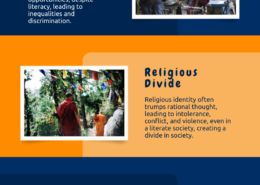What role does the idea of secularism play in India’s multireligious society?
Model Answer Introduction The family is a dynamic social institution in India, undergoing continuous transformation due to various factors. Traditionally, the family was seen as a collective unit, integral to Indian culture. However, changing social, economic, and cultural dynamics are reshaping famRead more
Model Answer
Introduction
The family is a dynamic social institution in India, undergoing continuous transformation due to various factors. Traditionally, the family was seen as a collective unit, integral to Indian culture. However, changing social, economic, and cultural dynamics are reshaping family structures and roles.
1. Transition from Joint to Nuclear Families
One of the significant changes in the family structure is the shift from joint families to nuclear setups. Increased mobility for education and employment, both within India and abroad, has led to families becoming smaller and more independent. For instance, many Indians now live in nuclear families in cities like Mumbai, Delhi, or even abroad, driven by job opportunities and the need for better living standards.
2. Changing Marriage Patterns
Marriage ages in India are rising, particularly for women, who are delaying marriage to focus on professional and educational goals. This shift is breaking traditional gender expectations, with educated urban women often marrying in their late 20s to advance in their careers.
3. Dissolution of Endogamy
Social mobility and access to education have led to a rise in interfaith and intercaste marriages, which were previously rare. This change challenges traditional norms, expanding the diversity within families and forcing them to adapt culturally. For instance, inter-caste marriages have increased from 2% to 5% of total marriages since the 1990s.
4. Redefinition of Family
The concept of family is broadening with the acceptance of same-sex relationships, cohabitation, single-parent families, adoption, and surrogate births. These developments challenge heteronormative views and further transform the family institution.
5. Gender Role Changes
Gender roles within families have evolved, with both men and women sharing income-earning, childcare, and household responsibilities. The increasing participation of women in the labor force is a key factor in this change.
6. Elder Care Shifts
The traditional model of caring for elderly parents at home is being replaced by reliance on old-age homes, as younger families in urban settings struggle to balance work and caregiving responsibilities.
7. Influence of Technology
Advances in technology and social media have redefined family relationships, enabling people to stay connected despite geographical distances. Tools like WhatsApp and Zoom are used daily by non-resident Indians (NRIs) to maintain close ties with their families in India.
Conclusion
In India, the family remains a crucial institution, but traditional assumptions about longevity, gender roles, and societal norms are being transformed. Changing societal attitudes, particularly regarding gender equality and individual autonomy, are re-shaping family structures and roles, reflecting the dynamic nature of the institution.
See less

The concept of secularism in India plays a critical role in managing the country's vast religious diversity, as India is home to multiple major religions, including Hinduism, Islam, Christianity, Sikhism, Buddhism, and Jainism, among others. Indian secularism, while distinct from Western secularism,Read more
The concept of secularism in India plays a critical role in managing the country’s vast religious diversity, as India is home to multiple major religions, including Hinduism, Islam, Christianity, Sikhism, Buddhism, and Jainism, among others. Indian secularism, while distinct from Western secularism, is designed to maintain religious harmony by promoting equality among all religions, protecting individual religious freedoms, and preventing the state from favoring any one religion. However, its functioning in such a complex religious landscape involves a delicate balance between ensuring religious neutrality, managing community-specific laws, and addressing tensions between religious communities.
1. Indian Secularism: Equal Respect for All Religions
2. State and Religion: No Official Religion, but Not Completely Separate
3. Secularism and Personal Laws
4. Secularism and Religious Tolerance
5. Secularism and Political Mobilization
6. Religious Minorities and Secularism
7. Secularism in Practice: Educational and Cultural Policies
8. Secularism and the Judiciary
9. Secularism and Globalization
Conclusion
Secularism in India is a complex and evolving concept that plays a crucial role in managing the country’s religious diversity. Indian secularism, with its emphasis on equal respect for all religions, aims to promote social harmony and protect the rights of religious minorities while allowing individuals to practice their faith freely. However, it faces challenges from religious polarization, political mobilization based on religion, and tensions between religious communities. As India continues to navigate its secular identity, the balance between respecting religious diversity and ensuring justice and equality for all remains a central concern in its democratic and pluralistic framework.
See less